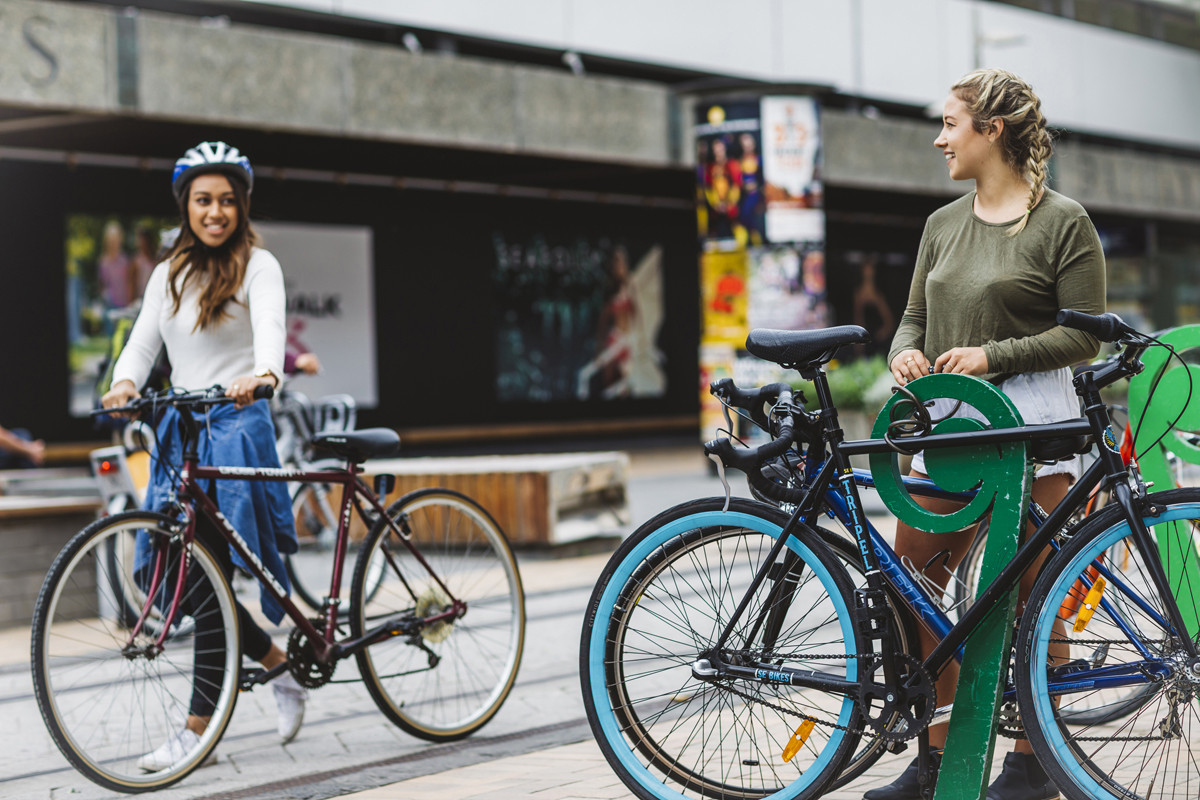
A fleet of bikes or e-bikes provided alongside or instead of fleet vehicles is an excellent way to encourage staff to take short trips by bike.
Bikes are a great way of getting across town to meetings because they:
Fleet bikes are also useful where a work site is spread out. A bike fleet will pay for itself after only a few hundred kilometres cycled.
In some jobs, close contact with the environment and ease of communication will help employees do their job better.
People on bikes can talk to people, observe things closely, and can get access to areas cars can’t go, making them perfect for site visits.
Find out the detail from these sections.
Once you’ve made the decision to introduce fleet bikes (see our business case section below), a good place to start for bike selection is to ask your local bike shop to provide some options, or you could directly approach manufacturers. You’ll want everything someone would need for a comfortable ride, which includes a bike which is fit for your purpose. Of course, that purpose will depend on how you expect the bike to be used – typically for short (up to 10km) trips – and the local topography (i.e. hills!). That could mean an e-bike. Our checklist below also lists the accessories you’ll need to consider (e.g. really good locks).
Download our checklist for facilities and equipment
And, of course, make sure your workplace is set up for bikes, by using the rest of this guide before you buy the bikes. That way a secure place to store bikes is already sorted as well as showers and lockers for staff to store gear in, as well as power points for e-bikes. Our checklist provides a complete list.
It’s a great idea to run a show and tell of your new bike, why not host a morning tea so people can check it out and ask any questions before they book it for an outing. On road cycle training is advisable and a great way of making sure that staff are not only confident but safe as well. Make sure the bike pool receives plenty of promotion and publicity by regularly featuring it in staff communications and pop some posters up around the office.
For many, the best approach might be to buy (or lease) a bike, and trial it for a few months.
CloseE-bikes are fast becoming a regular sight on our streets. They offer some significant advantages, such as flattening hills, avoiding getting hot and sweaty, and getting around quicker – all especially relevant for business travel. On the flip side, they do cost more, but if used regularly they can re-pay the additional investment.
So, in our hillier cities especially, like Auckland and Wellington, e-bikes can be an excellent choice as part of the vehicle fleet.
Download the fleet bike checklist
Find examples of workplaces leading in this area
CloseMany businesses see the inherent benefits of providing bikes or e-bikes for their staff to use during the working day – quick, healthy, low carbon. For others there may well be a need to develop a business case.
A simple business case is easy to do. Estimate the number of business trips which could be replaced by bikes (e.g. 20% of trips under 5km) and the usual cost of those trips (e.g. taxi or car). Surveying your people about their likely use of fleet bikes is also advisable. Compare that against the cost of either buying or leasing bikes, plus associated ongoing costs, and factoring in relative journey times. (In our larger cities, it may well be that the bike is quicker.)
A more detailed business case could involve making the bike consideration a part of a full vehicle fleet review, including analysis of existing fleet utilisation and the costs and benefits of a number of options, including bikes and car share.
CloseLike any asset, bikes need maintaining. As well as the mandatory pre-trip check by users, bikes should be regularly checked by a qualified bike mechanic. There are an increasing number of bike shops and other service providers who offer these maintenance services, often as part of a buy-and-service package or a bike-as-a-service (lease) package.
Download an example e-bike rider assessment and waiver [PDF, 202 KB]
CloseThe recent change to the Health and Safety at work legislation has given an added focus to the safety of people at work. But essentially, the responsibility of employers remains unchanged, and fleet bikes should be treated like any other type of equipment. The law change is not intended to stop people riding bikes for work-related travel. The key thing is that employers need to make sure there are appropriate systems in place to pro-actively manage risks. For riding bikes, this means things like ensuring bikes are well-maintained and that employees are appropriately trained to use them.
Read more about safety considerations
CloseElectric bikes CBD trial (Auckland Council) [PDF, 117 KB] - An example of a business case.
Safe Operating Guidelines: E-bikes for work-related travel (Auckland Council) [PDF, 493 KB]
E-bike how to guide (NZ Transport Agency) [PDF, 323 KB]
Interim e-bike policy (NZ Transport Agency) [PDF, 39 KB]
E-bike rider assessment & waiver (NZ Transport Agency / Electric Meg) [PDF, 202 KB]
CloseMercury
Mercury took its e-bike promotion in-house to enable their staff to use bikes for local business travel.
Wellington City Council
Wellington City Council introduced a fleet of bikes to motivate its people to make daily trips by bike.